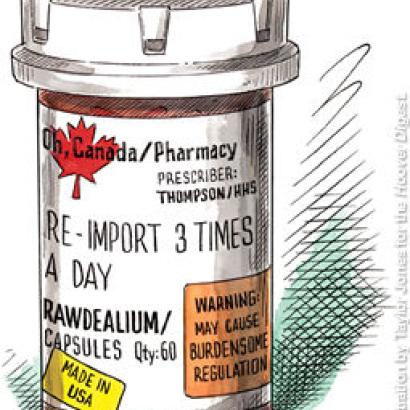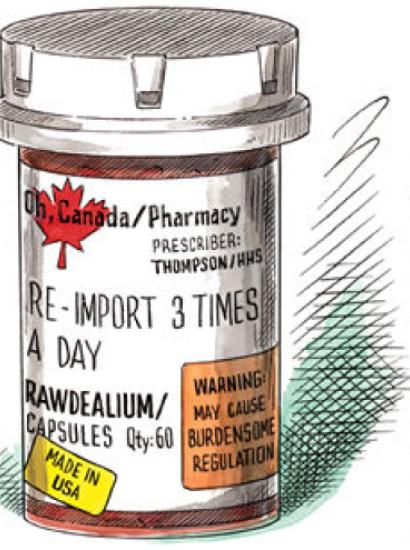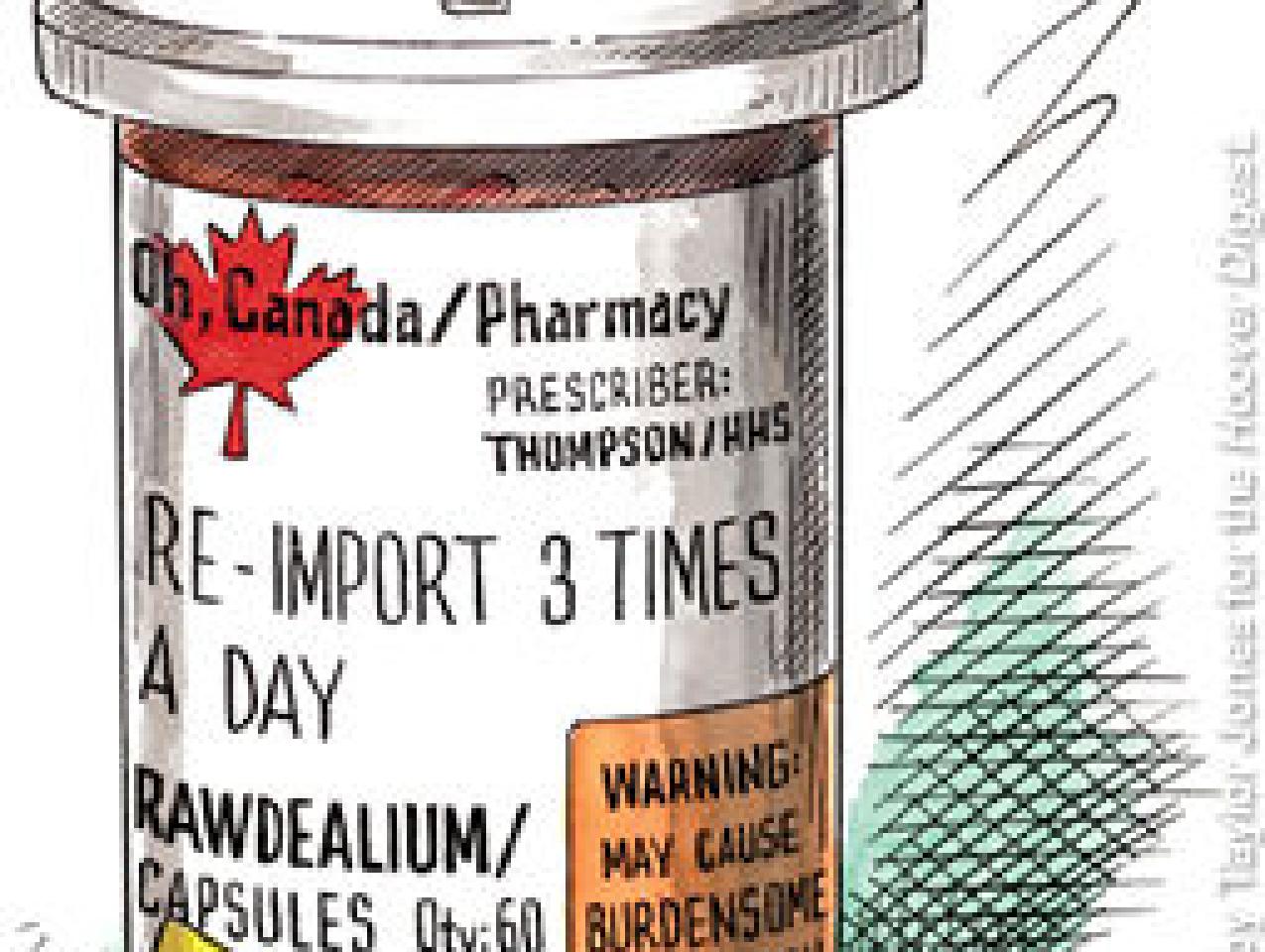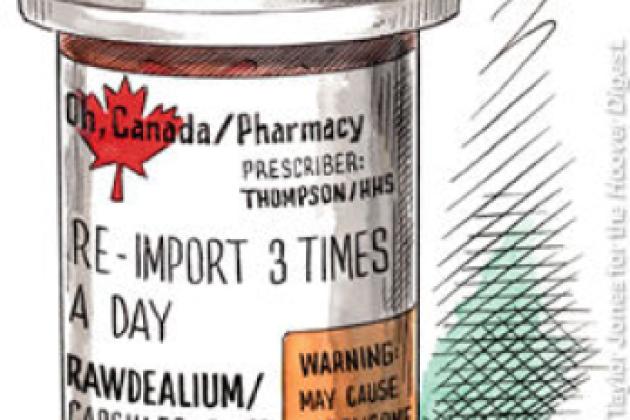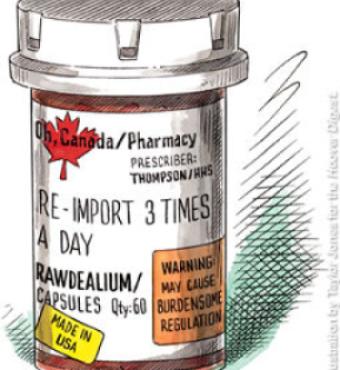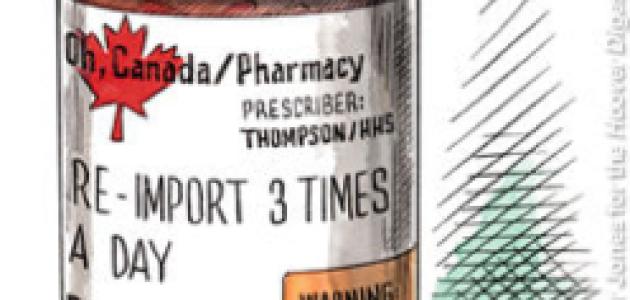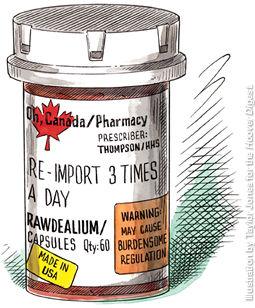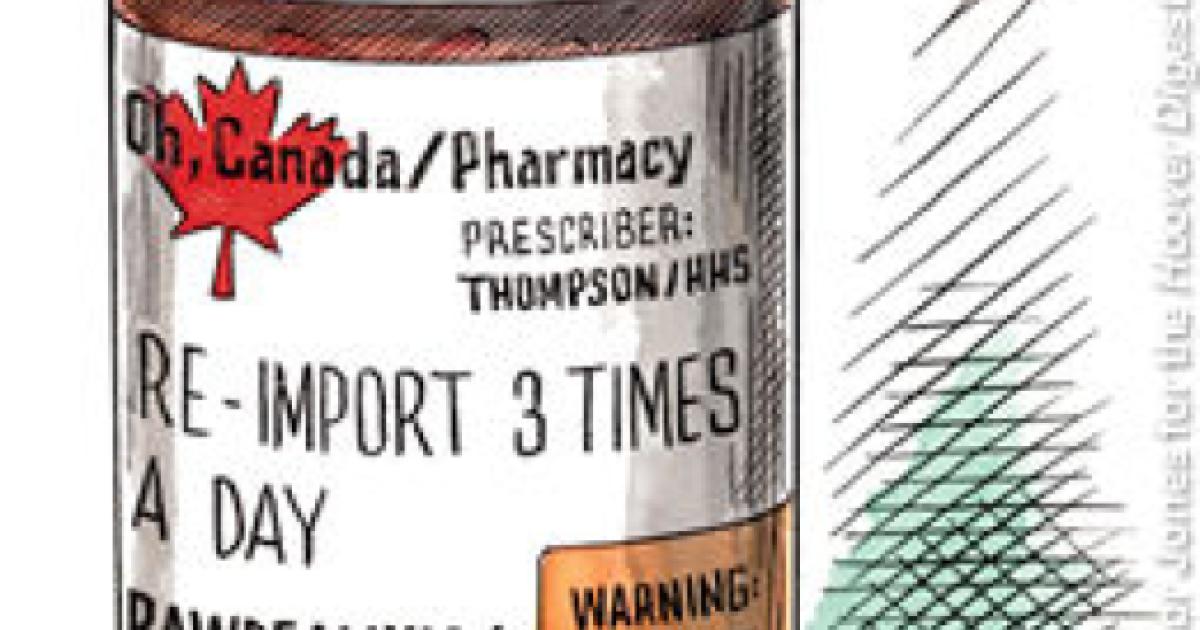- Health Care
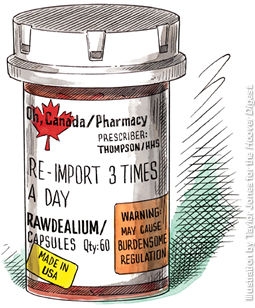
The lure of an alleged free lunch can be irresistible. Even a lunch at reduced prices is hard to ignore. This human desire for a bargain is part of America’s persistent interest in buying pharmaceuticals in Canada.
It seems so simple. Canadians pay less for prescription drugs than Americans. Why pay more when you can pay less? So a lot of Americans are jealous of what appears to be a good deal for Canadians.
Usually, this situation would solve itself naturally—Americans would import drugs from Canada rather than pay a premium for drugs in America. It’s not like American drugs are higher quality or have some other attribute that would justify the higher price. They’re the same product—they arrived in Canada from America. Only a fool would pay a premium when he can get the same thing cheaper elsewhere.
There’s only one problem. It’s against the law to import drugs from Canada. This should be an easy problem to fix. Let Americans import drugs from Canada. Americans get inexpensive drugs, so everybody should be better off, except the drug companies. And we know the drug companies have lots of money already, right? So although the drug companies will be upset, allowing drug re-importation should be wildly popular among seniors and the rest of us who care about them.
For some politicians, it’s as easy as a vote for motherhood and apple pie. In April, Senator Byron Dorgan, with bipartisan support from compatriots John McCain, Ted Kennedy, Debbie Stabenow, Trent Lott, and Olympia Snowe, introduced a bill that would allow Americans to re-import drugs from Canada. The FDA would inspect re-imported drugs to vouch for their safety.
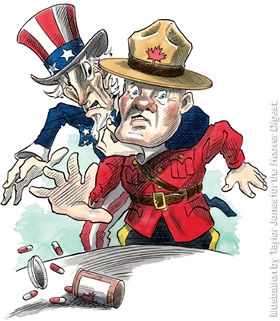
At the press conference announcing the legislation, the senators raged against corporate greed, spoke with passion about helping struggling seniors, and argued that allowing re-importation would be a boon to the American people. Senator after senator spoke with deep conviction about how this legislation would lower the price of pharmaceuticals.
Only one thing was missing from the discussion, and it is absent from almost every discussion of the disparity between American and Canadian drug prices: Why do Americans pay more than Canadians? The senators treated the Canadian prices as some sort of natural phenomenon. They treated the case for re-importation as just plain common sense, like spending your winter vacation in Florida rather than in Anchorage. Allowing re-importation would be like tearing down a fence keeping you from the Garden of Eden. Go west, young man, go west! Or in this case, go north, old man, go north. The fruit of paradise is within your reach.
But Canadian prices aren’t low because of some natural advantage inherent in Canadian pharmacies. Canadian prices are low because the Canadian government controls prices. The Canadian government caps the amount that U.S. pharmaceutical companies can charge Canadian pharmacies, distributors, and wholesalers. Those lower wholesale prices mean lower retail prices for Canadians compared to what Americans pay, at least for drugs under patent.
Once the border is open between Canada and America, Americans will want to buy their drugs en masse from Canada. American consumers will pay less for these medications, just as the senators desire. But this is unlikely to be the end of the story. Why would the pharmaceutical companies allow Canadian pharmacies and distributors to become their de facto wholesalers in the United States? This would mean dramatically lower profits.
Knowing that Canadian purchases of drugs will end up in America, the pharmaceutical companies will change their behavior. One obvious change is to limit the volume of drugs they sell to Canadians. But the Canadian government will have to change its behavior as well. If the Canadian government does nothing and keeps price controls at their current levels, Canadian wholesalers and retailers will prefer to sell drugs to Americans at higher prices rather than to Canadians at lower prices. Canadians will have trouble buying drugs in their own country.
So what will happen? Consider two extremes. In the first case, the Canadian government completely relaxes price controls to make sure that American manufacturers have an incentive to supply to Canada and that Canadian distributors have an incentive to keep supply in the country. In this case, the promised free lunch from re-importation evaporates. Instead of helping Americans, allowing re-importation merely punishes Canadians. The Canadian government is not going to find this extreme very attractive.
At the other extreme, price controls stay in place but the Canadian government restricts re-exportation back to the United States. Without Canadian policing, American manufacturers will withhold supplies from Canada to avoid losing all of their sales in the United States.
Efforts to restrict Canadian re-exports will be costly and by necessity only partially successful. Some Americans will get cheaper drugs, just as they do now via illegal imports. American pharmaceutical companies will lose profits on these sales.
The likely outcome will be somewhere between these two extremes: somewhat higher prices in Canada, slightly lower prices for those Americans who get access to the Canadian market, and slightly lower profits for American drug companies. What looked like a free lunch will turn out to be more of a snack.
Some narrowing of the price gap, while harmful to Canadians, will have a beneficial political side effect. As long as Canadians pay less for their drugs than Americans, there will be political pressure to “fix” the problem. Allowing re-importation of drugs is the least harmful response. Two other fixes would be much more damaging. The first would be for the American government to imitate Canada and put price controls on pharmaceuticals, which would have the potential to destroy the drug industry as we know it. Price controls, if set low enough, would dramatically reduce the profitability of new drug discovery, reducing the incentive to discover new drugs, a costly and highly unpredictable process.
American corporations are often accused of over-emphasizing short-run profitability. Yet drug companies invest billions in research and development where returns are unlikely to materialize within a decade. I am much more concerned about the time horizon of politicians. Are they going to be able to resist the temptation of low prices in the short run in exchange for less innovation in the future?
The second solution to the alleged high price of pharmaceuticals is for the American government to become the single buyer of drugs for the American market and, using that market power, resell the drugs to American pharmacies and distribute them through government health care programs. We have already started going down this slope—the Department of Veterans Affairs negotiates on behalf of veteran-covered health care. This saves money—veterans pay less than other Americans.
But there is no free lunch. Were this purchasing power to be extended to Medicare and Medicaid and beyond, we would be moving to a de facto system of price controls, where government budgetary pressures would be invoked to keep down the costs of drugs. Again the result would be lower prices today and less innovation tomorrow. This is not a trade-off most Americans would be willing to make. Who would want to punish their grandchildren in this way? The problem is that the benefits of low prices are immediate and visible. The costs to our grandchildren of drugs that are never developed will go unseen. The cries for low prices today may be difficult for politicians to ignore.
Having the U.S. government become the sole purchaser and then dispenser of drugs would give the drug industry the same sort of incentives we see in the defense industry. If the federal government pays the bills, it will also end up calling the shots. American companies make good fighter planes and bombers, but the government chooses the path that innovations take. This public-private cooperation works pretty well when your competitors are other governments designing and building fighter planes. It would be disastrous in medicine, where we are trying to outrun the angel of death.
There would be less innovation. Improvement would be incremental at best, and decisions about where research should turn would ultimately be driven by politics rather than medicine. In Canada, for example, pharmaceutical advertising is extremely limited. Companies can advertise a particular drug or a medical condition, but they can’t mention both in the same ad. The Canadian government doesn’t want citizens finding out about some new treatment for asthma or lowering cholesterol and demanding that the government start providing it. In Canada, the government decides which new drugs are worth having. We read about busloads of American seniors going to Canada for cheap drugs. But Canadians come to America for drugs because many of the drugs we enjoy are unavailable in Canada. In the trade-off between budgetary cost and medical improvement, budgetary cost would unfortunately carry a lot of weight.
Given these alternatives, which would have large, negative effects on future innovation, re-importation looks positively benign. Is there a better way to appease the appetite for a free lunch? I’m sympathetic to the call for lower drug prices. Who doesn’t sympathize with seniors struggling to afford their meds? But if I made a list of candidates to finance those lower prices, I’d start with family members, then private charities and foundations, then maybe, further down, the U.S. taxpayer.
My absolutely last choice to finance lower-priced drugs for struggling seniors would be the drug companies, their employees, and their stockholders. Why tax the people who take the risk and do the research and test the drugs? We offer drug companies patent protection to give them a chance to recoup the costs associated with developing and testing new drugs. The result has been a major contribution to human longevity and the quality of our lives. Drug re-importation, price controls, and having the U.S. government negotiate prices with pharmaceutical companies all have the same effect—they all begin to unravel the returns that create the incentive for innovation. Leave those incentives in place. If you want to help fund drug purchases for income-challenged elderly folks, let’s give the elderly money rather than cripple the drug industry.
If we’re still craving that free lunch, we’d be better off looking closer to home than across the border. The average cost of bringing a new drug to market is $800 million. Much of that cost is due to a Food and Drug Administration that is overly cautious in approving new drugs. This regulatory burden reduces innovation. Research gets channeled into the sure, big thing rather than the riskier, smaller opportunity. Reforming the FDA would bring down the prices of drugs and increase the number of drugs that come to market. We may envy the artificially low prices faced by Canadians and the other peoples around the world. Unlike re-importation, reforming the FDA will benefit Americans without punishing the rest of the world. And the incentives for future innovation will be enhanced rather than reduced.








